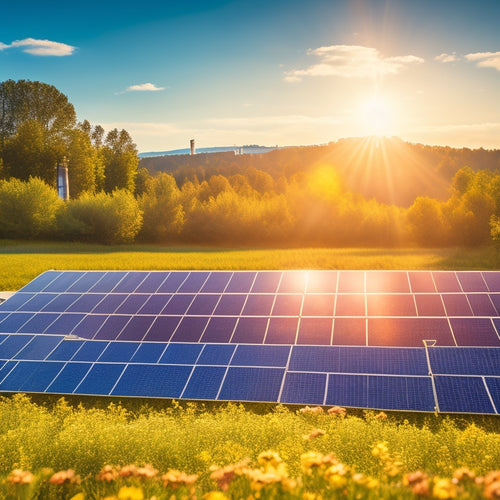
3 Tips for a Seamless Energy System Installation
Share
When designing an energy system, you'll want to assess your energy needs accurately to guarantee peak system performance. This involves conducting energy audits, identifying inefficiencies, and selecting compatible system components that meet your energy requirements. Additionally, plan for future expansions by prioritizing scalability, implementing modular components, and considering grid connection options. By following these three key tips, you'll be well on your way to a seamless energy system installation that sets you up for long-term success, and there's even more to investigate to maximize your system's potential.
Overview
- Conduct energy audits to accurately assess energy needs and identify areas for improvement before system design.
- Choose compatible system components that meet energy requirements, considering voltage, current, and power output for optimal performance.
- Ensure scalability in the initial system design to accommodate future energy demands and potential expansions.
- Verify inverter size matches solar array capacity to optimize energy production and reduce system inefficiencies.
- Implement future-proofing strategies with modular components to facilitate easy upgrades and adapt to changing energy needs.
Assess Energy Needs Accurately
Your facility's energy system is only as good as the data it relies on, so it's vital to assess your energy needs accurately. You must understand your energy consumption patterns to design a system that meets your specific requirements.
This involves analyzing your facility's energy usage, identifying areas of inefficiency, and determining opportunities for improvement. To do this, conduct an energy audit to determine daily energy consumption in watt-hours (Wh) energy audit and list all appliances and devices to power, noting wattage ratings from manufacturer labels.
Choose Compatible System Components
With a clear understanding of your energy needs, you can now focus on selecting system components that work harmoniously together. This is vital for achieving system compatibility, which is essential for a seamless energy system installation.
You'll want to choose components that not only meet your energy requirements but also guarantee component efficiency. Consider factors such as voltage, current, and power output when selecting components like solar panels, inverters, and batteries.
Confirm that each component is compatible with the others, and that they can operate efficiently within the system. For instance, verify the inverter size matches the solar array capacity for efficiency inverter efficiency ratings and verify compatibility with solar panel systems regarding DC source configuration and voltage range.
Plan for Future Expansion
During the initial system design, it's essential to contemplate potential future expansions to avoid costly reconfigurations or upgrades down the line.
You should prioritize scalability considerations to guarantee your system can adapt to growing energy demands.
Consider future proofing strategies, such as selecting modular components that can be easily added or replaced as needed, and opting for grid connection to secure a stable supply.
This approach allows for flexibility in panel orientation and tilt, enhancing energy production.
This forward-thinking approach will save you time, money, and hassle in the long run.
Frequently Asked Questions
Can I Install the Energy System Myself to Save Money?
You're considering a DIY installation to cut costs, but weigh the pros and cons: while you'll save on labor, you'll need to invest time and effort, and potential mistakes can lead to costly rework or even system failure.
How Do I Ensure the System Meets Local Building Codes?
Imagine maneuvering through a maze blindfolded - that's trying to install an energy system without knowing local building codes. You'll avoid the chaos by verifying your system's compliance with local regulations, ensuring a smooth installation that meets building code requirements.
What Kind of Maintenance Is Required for the System?
You'll want to prioritize system upkeep through routine inspections to guarantee peak performance, identifying potential issues before they become major problems, and making adjustments as needed to maintain your energy system running smoothly and efficiently.
Are Energy Storage Systems Compatible With My Existing Grid?
You'll need a compatibility assessment to confirm your energy storage system seamlessly integrates with your existing grid, assuring a smooth changeover to renewable energy and maximizing your independence from the grid.
Can I Finance My Energy System Installation Through a Loan?
As you gallop into the sunset of energy independence, you can corral financing through personal loan options or lasso government incentives, freeing you to capture the power of the sun without breaking the bank.
Ready to Buy
By following these three essential tips, you'll be well on your way to creating an energy system that's a harmony of efficiency, a marvel of modern technology, and a reflection of your own genius. Without them, you'll be stuck in a never-ending nightmare of malfunctioning components, wasted resources, and environmental guilt trips. The fate of your energy system hangs in the balance - choose wisely!
Related Posts
-

Top Eco-Friendly Camping Equipment for a Sustainable Adventure
When you're camping with the planet in mind, opt for eco-friendly gear like tents made from recycled materials and bi...
-

Advantages of Solar Generating Systems Over Traditional Energy
Solar generating systems provide several key advantages over traditional energy sources. You'll experience lower long...
-

Essential Hiking Lights for Safety and Fun
When you're hitting the trails, essential hiking lights are vital for safety and fun. A lightweight headlamp offers h...


